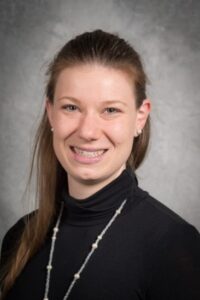
Project perspectives III: interview with Katharina Heil

Katharina Heil is the Scientific Project Manager of the euCanSHare and EarlyCause project at the Artificial Intelligence in Medicine Lab (BCN-AIM) of the University of Barcelona. Besides, she overlooks the overall functioning of the longITools project and, as Lab Manager, she is in charge of ensuring the timely progress of projects, internal processes and external representation.
Katharina completed her undergraduate studies in Wuerzburg, Germany and Buenos Aires, Argentina, where she obtained a BSc in Biomedical Sciences. She got an MSc in Biomedicine and Bioinformatics, from Universitat de Barcelona and Universitat Autónoma de Barcelona. In 2017 she obtained her PhD joint degree from the University of Edinburgh and KTH, Stockholm.
What is your role in euCanSHare? As euCanSHare’s Scientific Project Manager I am in charge of supporting the well-functioning of the project considering administrative and scientific aspects, and support the Project Coordinator, Karim Lekadir. My overall role is to establish and guarantee full synergy, motivation, integration and effective interaction among euCanSHare partners with the final aim of delivering successful progress of the project within the agreed time, cost and quality limits. On a day to day basis, this means that I am in charge of (1) accommodating the EU-Canada nature of the project, (2) allowing cohesive interactions between IT and data-related project components, (3) supporting project partners and the project coordinator with deliverable and report generation, (4) Ensuring overall project development based on the euCanSHare proposal.
What does a normal day in your Project Manager life look like? As a Project Manager, every day is different. Some tasks can be foreseen while others come up spontaneously and require immediate reactions. Generally, I am in touch with project partners via email and meet them on a regular basis through video calls. In some way, the pandemic has made the virtual interaction more normal, even though, especially with time, in-person events are being missed. Another recurring task is the organisation and support of meetings and report and deliverable writing. Within the euCanSHare project, I am also supporting communication and dissemination initiatives to share the project mission and findings with a wider audience.
Where do you see the beauty of the Europe-Canadian collaboration in the euCanSHare project? International collaboration is a key driver to success. Even if the world is coming closer and closer, joint conversations are necessary to, for instance, share best practices being adopted in different regions of the world. The beauty of the EU-Canada collaboration in euCanSHare is the constant contact, knowledge and foreseen data exchange between two continents. euCanSHare is already showing first outputs with many more to be expected during the remaining project time.
What was so far the biggest milestone you feel that euCanSHare and its involved researchers have achieved? Milestones can be of many sizes and several have been reached during the first two years of the project.
In your opinion, what can the euCanSHare data catalogue and platform contribute to the cardiac research community? Given the properties described above, the euCanSHare platform is a great contribution to making cardiovascular research data findable, accessible, interoperable, and reusable – following the FAIR Data Principle. Additionally, the platforms focus on its usability for and by all kinds of cardiovascular researchers, including clinicians and others makes the resource interesting to a large audience, supplying a variety of possibilities to use and leverage the data and available tools to gain insights into open research questions.
What do you think motivates researchers, clinicians and others to contribute to euCanSHare? Sharing data and making it more accessible in a secure and protected way, at no point forgetting to acknowledge the corresponding contributors is attractive to many, yet still a large challenge. The euCanSHare platform will allow to keep data save, controlled yet make it findable for the research community. This is a driving factor for professionals in any field of cardiovascular research to contribute. The project partners are doing their best to ensure user-friendliness, generating, for example, tutorials, informative resources and in that way creating a platform “for everyone”.
What are the major difficulties and challenges of managing such large and multidisciplinary projects? When working in interdisciplinary and international settings it is always challenging to find best possible ways to make use of every partners, individual expertise for the benefit of all. To ensure individual contribution, within euCanSHare different working groups focus on key aspects and challenges of the project allowing to leverage knowledge and follow foreseen work plans. Another challenge is losing sight of the overall project aim, especially since everyday work is mainly concentrated on individual aspects. Consortium meetings, happening on a regular basis are great check-in moments for all consortium partners to come together and update each other on the most recent advances and putting them back into the overall project perspective.
Today is International Women’s Day. In your experience, what is the perception of women as research managers? Today on “International Women’s Day” I would like to highlight the great work so many women are doing to support and manage research projects. I am confident to say that the organisational talent I often see is a much needed and required skill for successful project management. Diplomatic and clear communication is definitely one of “our strengths” as well. I risk myself to say that often female research managers are seen as project support, but I would stress that they are a necessary and indispensable part of strong project management.
Would you encourage girls’ education in science, technology, engineering and mathematics (STEM)? What is your experience? Anyone can be a scientist – and on top of that it is worthwhile to remember that a scientist does not by default need to be the “classical scientist” we think of. I, myself, am a Project Manager in science, have completed scientific studies and obtained a PhD. As of today, I am working with and for scientists on a daily basis and still consider myself a scientist. Today’s world is full of opportunities, thanks to many others who have paved the way for women in science. Hence my tip for girls and anyone interested in becoming a scientist is to explore options and give it a try! From my point of view, one key ingredient to become a scientist is curiosity and drive to ask and learn more, to discover and be open to new ideas, insights and knowledge. Since I was a child I was fascinated by nature and the human body. I followed my interests, studied human biology and acquired skills to do so using computational tools. And today I am happy to say that I can combine knowledge from all these areas to keep contributing to scientific advances in an interdisciplinary area. Even though the way is not always straight forward – I can only advise you to be curious – choose your way towards a scientific career and as long as you remain interested and open to possibilities, everyone can and will be able to become a scientist – of whatever form imaginable.
What is your message about euCanSHare to external stakeholders? euCanSHare and its platform are a representation of how data can be used and made available to a wide research audience. It depends on each and every player in the field to make such endeavours possible and the euCanSHare team is establishing the tools and interfaces to use to allow others to openly contribute to the effort towards FAIR cardiovascular data and the possibility to use and analyse it to advance research and clinical practice. The consortium is open to collaborate and happy to hear your thoughts and ideas – don’t hesitate to reach out with ideas and questions.
What else would you like to share with the reader? I am glad and thankful to be able to contribute to the success of the project together with Karim Lekadir, the project coordinator at the University of Barcelona and together with all the additional 16 project partners. It is inspiring to see how advances are made, pieces are put together and scientific progress is being made.

